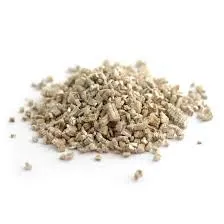Th8 . 13, 2024 15:32 Back to list
Exploring the Properties and Applications of Thermal Conductors and Insulators in Modern Engineering
Understanding Thermal Conductors and Insulators Key Materials and Their Applications
Thermal conductivity is a crucial property in materials science, dictating how well a material can conduct heat. Materials can be broadly classified into thermal conductors and thermal insulators based on their ability to transfer heat. Understanding these classifications is vital for various applications in engineering, construction, and everyday life.
Thermal Conductors
Thermal conductors are materials that allow heat to flow through them easily. Metals are the most common examples of thermal conductors. Among them, copper and aluminum are widely used due to their excellent thermal conductivity. Copper, with a thermal conductivity of around 401 W/m·K, is often used in electrical wires, heat sinks, and cookware. Aluminum, slightly less conductive at about 237 W/m·K, is favored in applications involving lightweight structures and heat exchangers.
Beyond metals, certain non-metallic materials, such as diamond, exhibit remarkable thermal conductivity. Diamonds can transfer heat at approximately 2200 W/m·K, making them exceptionally useful in high-performance heat management applications. This property has led to the use of diamond in electronic devices, where effective heat dissipation is critical for performance and longevity.
Thermal Insulators
In contrast, thermal insulators are materials that resist the flow of heat. They are essential in applications where heat retention or prevention of heat loss is desired. Common insulators include materials such as fiberglass, polystyrene, and polyurethane. The effectiveness of an insulating material is often described by its thermal conductivity; the lower the value, the better the insulator.
Fiberglass, made from fine glass fibers, has a low thermal conductivity ranging from 0.03 to 0.04 W/m·K. This property makes it ideal for use in building insulation and refrigeration. Similarly, polystyrene foam, commonly used in packaging and insulation panels, offers stiffness and strength while maintaining low thermal conductivity.
thermal conductors and insulators materials

Another notable insulating material is aerogel, often referred to as frozen smoke. Aerogel can have a thermal conductivity as low as 0.013 W/m·K, making it one of the most efficient insulators on the market. Its applications extend from aerospace engineering to architectural design, where energy efficiency is a paramount concern.
Applications and Importance
The choice between conductors and insulators has profound implications in various fields. In the construction industry, for example, selecting appropriate insulating materials can significantly enhance energy efficiency in buildings, leading to reduced heating and cooling costs. Effective thermal insulation is not just an energy-saving measure; it also contributes to comfort and environmental sustainability.
In electronics, thermal management is critical to prevent overheating in devices. This is where thermal conductors come into play, dissipating heat away from sensitive components. Proper heat sinks made from copper or aluminum are crucial for the longevity and performance of everything from computers to smartphones.
Furthermore, the development of new materials is continuously improving the field of thermal management. Research into nanomaterials and composites is paving the way for more effective thermal conductors and insulators that can meet the demands of modern technology.
Conclusion
The distinction between thermal conductors and insulators is fundamental to material selection in numerous applications. By understanding the properties and uses of various materials, industries can improve energy efficiency, enhance performance, and contribute to sustainability. As science progresses, we can anticipate the emergence of innovative solutions that will redefine the standards of thermal management. Whether it’s for construction, electronics, or innovative engineering applications, the interplay between thermal conductors and insulators remains a dynamic and essential field of study.
-
High-Quality Fe-C Alloy Leading Manufacturers & Spherical Alloy Materials Supplier
NewsJun.10,2025
-
Premium Low Nitrogen Recarburiser Supplier & Manufacturer – High Quality Exporters
NewsJun.10,2025
-
DT4 High-Quality Magnetic Materials Leading DT4 Manufacturer & Supplier
NewsJun.10,2025
-
High-Performance Spring Steel Suppliers Custom Solutions
NewsJun.10,2025
-
Premium SWRCH6A Manufacturer Steel Wire Supplier & Factory
NewsJun.10,2025
-
Premium Mild Steel Wire Rod Supplier & Manufacturer
NewsJun.10,2025
